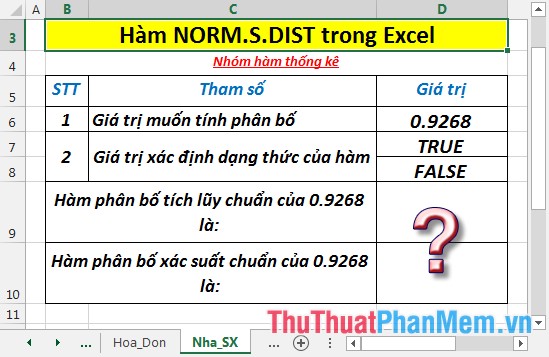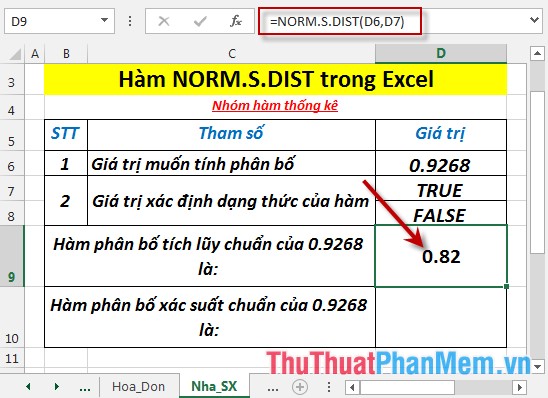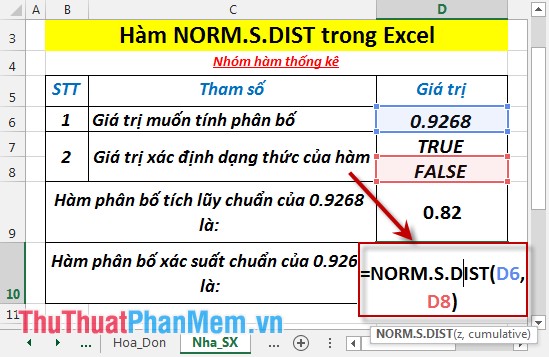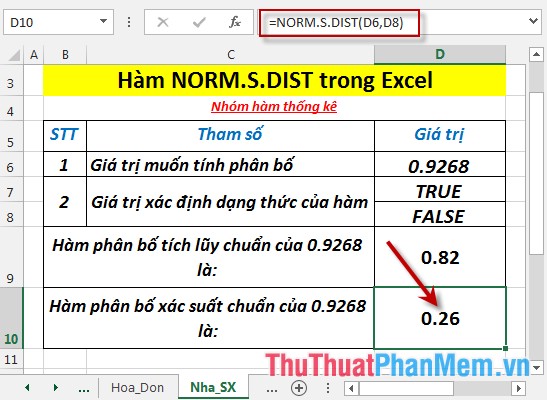NORM.S.DIST function - The function returns the normalized distribution with a mean of 0 and a standard deviation of 1 in Excel
The following article introduces you to the NORM.S.DIST function - one of the functions in the statistical function group is very popular in Excel.

Description: The normalized distribution function has a mean of 0 and a standard deviation of 1. Use the function instead of a table containing normalized curve areas. Support functions from Excel 2010 onwards.
Syntax: NORM.S.DIST (z, cumulative)
Inside:
- z: The value you want to calculate the distribution, is a required parameter .
- cumulative: A logical value that determines the form of the function, which is a required parameter, including:
+ cumulative = True -> returns the cumulative distribution function.
+ cumulative = False -> returns the probability density function.
Attention:
- If z is not a number -> the function returns the #VALUE! Error value
- The equation for the standardized density function is:
[fleft (z right) = frac {1} {{sqrt {2pi}}} {e ^ {- frac {{{z ^ 2}}} {2}}}]
For example:
Find the normalized distribution of values in the following data table:

- Calculate the value of standardized cumulative distribution function (corresponding to True value ) In a cell to calculate, enter the formula : = NORM.S.DIST (D6, D7)
- Press Enter -> standard cumulative distribution function value is:

- Calculate the value of the standard probability distribution function (corresponding to the value of False). In a cell to calculate, enter the formula : = NORM.S.DIST (D6, D8)

- Press Enter -> the standard probability distribution function value is:

Above are instructions and some specific examples when using the NORM.S.DIST function in Excel.
Good luck!
You should read it
- NORM.INV function - The function returns the inverse of the standard cumulative distribution in Excel
- CONFIDENCE.NORM function - The function returns the confidence interval of the population by using a normalized distribution in Excel
- LOGNORM.DIST - Function returns the logarithmic distribution of x in Excel
- POISSON.DIST function - The function returns the Poisson distribution in Excel
- GAMMA.DIST function - The function returns the gamma distribution in Excel
- BETA.DIST function - The function returns the Beta distribution in Excel
- HYPGEOM.DIST - The function returns the hyperbolic distribution in Excel
- F.DIST - The function returns the probability distribution F in Excel
May be interested
- STANDARDIZE function - The function returns the normalized value from a specific distribution in Excel
 standardize function: the function returns the normalized value from a distribution characterized by mean and standard_dev arguments. syntax: standardize (x, mean, standard_dev)
standardize function: the function returns the normalized value from a distribution characterized by mean and standard_dev arguments. syntax: standardize (x, mean, standard_dev) - NORMDIST function - The function returns the normal distribution with the standard deviation and the average value specified in Excel
 the following article details the normdist function - the function returns the normal distribution in excel.
the following article details the normdist function - the function returns the normal distribution in excel. - LOGNORM.INV function - The function returns the inverse of the logarithmic distribution of x in Excel
 lognorm.inv: the function returns the inverse of the logarithmic distribution of x. where ln (x) is usually distributed with parameter mean and standard deviation. use functions to analyze logarithmic change data. support function from excel 2 version
lognorm.inv: the function returns the inverse of the logarithmic distribution of x. where ln (x) is usually distributed with parameter mean and standard deviation. use functions to analyze logarithmic change data. support function from excel 2 version - LOGNORM.DIST - Function returns the logarithmic distribution of x in Excel
 lognorm.dist: the function returns the logarithmic distribution of x. where ln (x) is usually distributed with parameter mean and standard deviation. support functions from excel 2010 onwards. syntax: lognorm.dist (x, mean, standard_dev, cumulative)
lognorm.dist: the function returns the logarithmic distribution of x. where ln (x) is usually distributed with parameter mean and standard deviation. support functions from excel 2010 onwards. syntax: lognorm.dist (x, mean, standard_dev, cumulative) - PHI function - The function returns the value of the density function for a normal distribution in Excel
 phi function: the function returns the value of the density function for a standard normal distribution. support functions from excel 2013 onwards. syntax: phi (x)
phi function: the function returns the value of the density function for a standard normal distribution. support functions from excel 2013 onwards. syntax: phi (x) - WEIBULL function - The function returns the Weibull distribution in Excel
 the function performs the calculation and returns the weibull distribution. based on this distribution to analyze reliability in theory such as calculating the average life of the device or used in the field of meteorology, hydrology and weather forecast.
the function performs the calculation and returns the weibull distribution. based on this distribution to analyze reliability in theory such as calculating the average life of the device or used in the field of meteorology, hydrology and weather forecast. - How to use NORMDIST function in Excel
 normdist is a function that returns a distribution with a standard deviation and a confirmed average. the normdist function applies in statistics, including hypothesis testing.
normdist is a function that returns a distribution with a standard deviation and a confirmed average. the normdist function applies in statistics, including hypothesis testing. - BINOM.INV function - The function returns the smallest value with cumulative binomial distribution greater or equal to the standard value in Excel
 binom.inv function: the function returns the smallest value with cumulative binomial distribution greater or equal to the standard value. support functions from the excel 2010 version. syntax: binom.inv (trials, probability_s, alpha)
binom.inv function: the function returns the smallest value with cumulative binomial distribution greater or equal to the standard value. support functions from the excel 2010 version. syntax: binom.inv (trials, probability_s, alpha) - GAMMA.INV function - The function returns the inverse of the gamma distribution in Excel
 gamma.inv: the function returns the inverse of the gamma distribution, using this function to study their distribution variables that may be symmetrical. support functions from excel 2010 onwards. syntax: gamma.inv (probability, alpha, beta)
gamma.inv: the function returns the inverse of the gamma distribution, using this function to study their distribution variables that may be symmetrical. support functions from excel 2010 onwards. syntax: gamma.inv (probability, alpha, beta) - GAMMA.DIST function - The function returns the gamma distribution in Excel
 gamma.dist: the function returns the gamma distribution, using this function to study skewed distribution variables. support functions from excel 2010 onwards. syntax: gamma.dist (x, alpha, beta, cumulative)
gamma.dist: the function returns the gamma distribution, using this function to study skewed distribution variables. support functions from excel 2010 onwards. syntax: gamma.dist (x, alpha, beta, cumulative)










 PEARSON function - The function returns the Pearson product moment correlation coefficient in Excel
PEARSON function - The function returns the Pearson product moment correlation coefficient in Excel PERCENTILE.EXC function - The function returns the kth percentile of values in the range, with k in the range from 0 to 1 in Excel
PERCENTILE.EXC function - The function returns the kth percentile of values in the range, with k in the range from 0 to 1 in Excel PERCENTILE.INC function - Function returns the kth percentile of values in the range with k in the range from 0 to 1 in Excel
PERCENTILE.INC function - Function returns the kth percentile of values in the range with k in the range from 0 to 1 in Excel PERMUT function - The function returns the number of permutations of a given number of objects in Excel
PERMUT function - The function returns the number of permutations of a given number of objects in Excel PERMUTATIONA function - The function returns the number of permutations (can be repeated) of a given object in Excel
PERMUTATIONA function - The function returns the number of permutations (can be repeated) of a given object in Excel